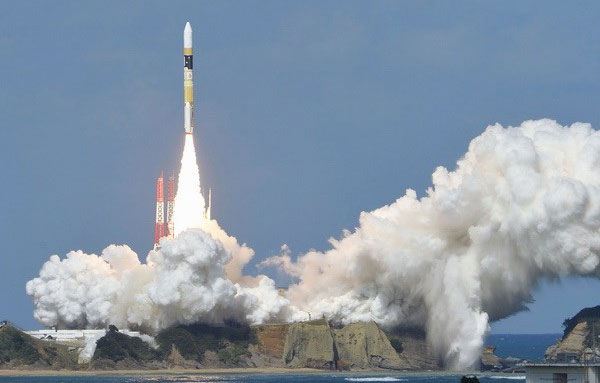Japan launches the world's most advanced satellite
Japan Meteorological Agency (JMA) said on October 7, Japan successfully launched the Himawari-8 weather observing satellite from Tanegashima space center in Kagoshima Prefecture, southwestern Japan.
The satellite launch is a Japanese effort to improve the accuracy of forecasting weather phenomena that can lead to natural disasters.

The H-2A rocket carries the Himawari-8 satellite leaving the launch pad.(Photo: Kyodo / TTXVN)
Himawari-8 satellite , made by Mitsubishi Electric Corp. manufactured, weighs about 3,500kg (including fuel-filled tank when placed on a launch pad) and is the latest generation weather observation satellite, equipped with advanced imaging equipment (AHI). This is the world's most technologically advanced observation device, allowing satellites to be observed in cloudy conditions and at night.
It also provides real-time images, true colors of clouds and high-resolution storms, measuring the amount of volcanic ash emitted into the air when the volcano is active.
Himawari-8 can also observe the weather conditions in an area on a regular basis, taking photos every 10 minutes, compared to 30 minutes according to the current Himawari-7 satellite. Thus, Himawari-8 is expected to support and improve broad-scale hydro-meteorological activities, such as weather forecasting, climate monitoring, disaster prevention, air traffic control.
Himawari satellite is expected to officially start operating from July 2015. Japan also plans to launch Himawari-9 backup satellite in fiscal 2016.
The title has been changed.
- Japan successfully launched Daichi-2 satellite
- Russia spoiled the satellite again
- Japan launches missiles carrying the first commercial satellite
- Japan launched a satellite that could identify 1m objects, take night photos
- Japan is about to launch a global disaster observation satellite
- Bolivia launches satellites in China
- Japan jumped into the field of launching satellites
- Japan launches satellite tracking global rainfall
- Korea will launch the satellite after two failed attempts
- Video: Japan launches a satellite to study black holes
- Japan plans to launch a spy satellite
- Japan develops 'eye gods' to deal with the invasion of its territorial waters
 Van Allen's belt and evidence that the Apollo 11 mission to the Moon was myth
Van Allen's belt and evidence that the Apollo 11 mission to the Moon was myth The levels of civilization in the universe (Kardashev scale)
The levels of civilization in the universe (Kardashev scale) Today Mars, the sun and the Earth are aligned
Today Mars, the sun and the Earth are aligned The Amazon owner announced a secret plan to build a space base for thousands of people
The Amazon owner announced a secret plan to build a space base for thousands of people